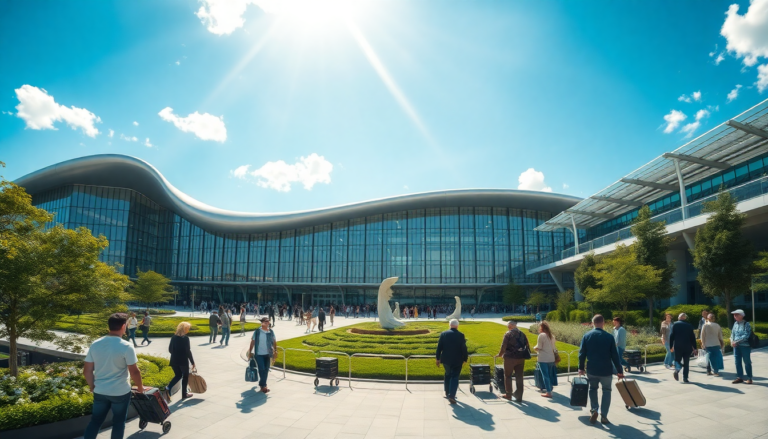Argomenti trattati
Airports have traditionally been just stepping stones in our travels, but the upcoming Prix Versailles 2025 is set to transform these gateways into stunning architectural wonders. This award goes beyond just looks; it celebrates the intricate blend of innovation, sustainability, and cultural heritage. This year’s winners, hailing from China, France, Japan, and the United States, embody the evolution of airports into vibrant spaces that reflect the essence of their locales. Isn’t it fascinating how these structures can tell a story about where we are?
The Essence of Airport Architecture
The Prix Versailles recognizes architectural excellence in airports worldwide, focusing on designs that seamlessly merge functionality with artistic flair. Jérôme Gouadain, the general secretary of the Prix Versailles, points out that these airports symbolize contemporary global heritage, striking a balance between operational efficiency and artistic design. Have you ever marveled at how some airports feel more like art galleries than transit hubs?
In recent years, airports have evolved into cultural landmarks, reflecting the rich narratives of the regions they serve. Each terminal is a story waiting to be told through its design, materials, and integration with the surrounding landscape, showcasing how architecture can convey local identity. Isn’t it incredible how a simple building can embody the spirit of a place?
Spotlighting the 2025 Winners
This year’s prestigious award has been given to six airports that stand out for their innovative designs and commitment to sustainability. Take, for example, the new Terminal 2 in Yantai, China. Spanning an impressive 167,000 square meters, this terminal pays homage to the breathtaking coastal landscape. Designed by Aedas in collaboration with CSWADI, its roofline mimics the majestic Kunyu Mountains, embodying both dynamism and harmony. How does a structure manage to capture the beauty of nature so effectively?
The terminal’s ‘E’-shaped layout maximizes passenger flow while minimizing land impact, demonstrating a commitment to flexible operations. Natural light floods the space, culminating in a stunning glass dome, while the interior’s curves and materials echo the surrounding environment. Wood elements reference the Maritime Silk Road, making it a true emblem of the Shandong Peninsula. Can you imagine stepping into such an inspiring setting?
Another remarkable winner is the newly expanded ‘Cœur’ terminal at Marseille Provence Airport, designed by Foster + Partners. This addition spans 22,000 square meters and integrates 70% recycled steel, featuring a roof with inverted beams that promotes natural ventilation. The design pays respect to the original terminal from the 1960s while offering travelers a tranquil experience reminiscent of the old port’s houseboats, framed by breathtaking views of the Provençal countryside and nearby lagoon.
Innovative Approaches to Sustainability
As we face the challenges posed by climate change, sustainability has never been more crucial. The new arrival terminal in Réunion, France, is the first bioclimatic tropical airport of its size, crafted with input from 91% local companies. At its core lies an innovative ‘canyon’ that acts as a thermal chimney, enhancing natural ventilation, while 830 adjustable louvers adapt to the island’s trade winds, creating a seamless connection to its environment. Isn’t it exciting to see architecture so in tune with nature?
In Japan, the Kansai International Airport, originally envisioned by Renzo Piano, showcases an elegant structure revitalized to boost capacity by 25%. The recent renovations emphasize natural materials and a queue management system that enhances passenger flow. This balance of legacy and modernity is just in time for the 2025 World Expo. What’s more inspiring than an airport that honors its past while looking to the future?
Furthermore, the new Portland Terminal, designed by ZGF, draws from Oregon’s lush forests. Its expansive wooden roof, covering over 36,000 square meters, symbolizes local innovation in forestry. Materials sourced within a 500-kilometer radius, along with a ‘forest to frame’ approach, ensure transparency in the timber supply chain, enhancing the terminal’s connection to its natural surroundings. How does such sustainable design change our perception of travel?
A Cultural Destination
San Francisco’s Terminal 1 exemplifies ambitious transformation, featuring 25 new gates and achieving a remarkable 79% reduction in carbon footprint. Designed by Gensler, it welcomes travelers with an abundance of natural light, creating a peaceful atmosphere. The architecture celebrates the region’s crafts, transforming the terminal into a cultural hub with the SFO Museum, the only accredited museum within an airport worldwide. Isn’t it incredible how airports can double as cultural experiences?
Lastly, the terminal pays homage to Harvey Milk, a pioneer of inclusion, ensuring that the structure resonates with social significance while maintaining architectural excellence. Each of these airports not only serves as a transit hub but also plays a vital role in their communities, inviting travelers to immerse themselves in the stories and cultures they represent. As we navigate these magnificent spaces, we are reminded that behind every terminal lies a narrative waiting to unfold, encouraging us to embrace the journey as much as the destination.

